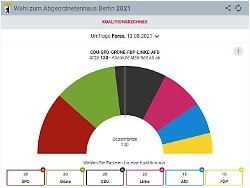Sunday, September 19, 2021
Election to the House of Representatives
Who with whom on the Spree?
By Martin Morcinek
Big election day in the German capital: Parallel to the federal election, around 2.5 million Berliners will also vote on the political balance of power at the state level on September 26th. The ntv.de coalition calculator for house elections.
Exciting election decision in Berlin: In the capital, the election to the state parliament – the Berlin House of Representatives – was a close neck-and-neck race. Will there be a continuation of red-red-green? Which other party alliances would be theoretically conceivable on the basis of the latest surveys?
The Berlin House of Representatives has at least 130 seats. The threshold for an absolute majority is 66 seats. However, the exact majority ratios can only be calculated after the election, when the number of overhang and compensatory mandates has been determined.
A total of 78 seats will be directly elected with the first vote in the House of Representatives election in the Berlin constituencies. The remaining seats are determined by the lists of the parties and their shares in the second votes. In the previous Berlin election, this resulted in a total of 160 MPs, as some parties received overhang and other compensatory mandates based on the 2016 election results.
At that time, 38 seats were allocated to the SPD, which made it the strongest parliamentary group in the Berlin House of Representatives. The Berlin CDU was able to claim 31 seats. The Greens and the Left had a parliamentary group with 27 MPs each. The AfD was represented with 22 seats, the Berlin FDP with 11. Four other MPs were last non-attached.
